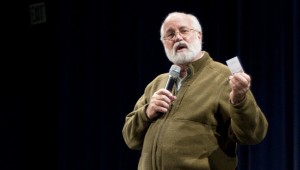Located at the northern edge of Chinatown, just two miles southeast of Dodger Stadium and a mile north of City Hall, Homeboy Industries stands out against the backdrop of a towering train overpass, across from nondescript buildings adorned in Chinese script and a massive lot half-filled with yellow school buses. It’s literally the end of the line.
When I first approached the headquarters of one of Los Angeles’ most effective gang rehabilitation programs, the first thing that stood out was its color. Dark orange with a yellow hue, the building works in stark contrast with the pale grey that dominates the surrounding urban terrain.
It wasn’t until I walked inside and was greeted by a receptionist, who had more tattoos than empty skin, that the full weight of this building’s significance began to emerge.
For those who don’t know, Homeboy Industries provides workshops, classes and training programs that range from building resumes to kicking drug habits for men and women formerly involved in gangs. As a nonprofit, it relies primarily on donations and revenues from its food production to keep the lights on.

Which brings us back to UCLA. Last week, USAC President John Joanino announced that a deal had been struck that allowed Homeboy products, such as chips and salsa, to be sold inside ASUCLA stores.
It’s a win-win situation. Homeboy gets more money, we get delicious food. However, the most important thing about this development is its potential to expand UCLA’s collective consciousness about the city it sits in.
Westwood lies in a metropolis that holds nearly four million people. Yet it’s fair to say that most undergraduates who attend this school spend most of their four years within the confines of the Westside. Most go to Santa Monica, many go to Hollywood, but only a few brave souls venture farther east than Western Avenue.
Our collective understanding of the social infrastructure that envelops the city we all live in is dim at best.Homeboy lies only 15 miles east of UCLA, but it might as well be another world.
Of course, that’s not to say there aren’t scores of UCLA students doing good work in the L.A. community. Besides the Community Programs Office, which institutionalizes a number of student outreach efforts, cultural organizations also carry on a number of student-initiated tutoring and community service projects downtown and in other Los Angeles neighborhoods.
But these outreach efforts engage only the students who seek them out, leaving a large portion of the campus physically and culturally separated from the city’s metropolitan centers.
For those students, partnerships like the one with Homeboy Industries put the community on display here without requiring a weekly volunteer commitment, encouraging them to learn more about the area they live in.
And it couldn’t come at a more crucial time for the city.
The fact is that Los Angeles is a city in transition. Downtown has been reinvigorated by a steady stream of investments and an active mayor. Just this year, the city saw its first New Year’s Eve party. Metro continues to install new rail routes that will make car-less mobility easier, Los Feliz and Silver Lake continue to attract an entirely new brand of hipster, and long-neglected areas in South Los Angeles, like Jefferson Park around USC, have begun to see redevelopment.
It’s not all good, though. Redevelopment tends to bring gentrification, which is fraught with its own issues.In fact, rents have begun soaring, pricing many apartments out of affordable ranges for low-income residents.Enhanced public transit is coming, but slowly, especially because some areas, like Beverly Hills, find being obstructionist, rather than progressive, more useful. Violent crime in many areas remains up, as does smog and traffic.
A bag of chips isn’t going to magically entice students into caring about these issues. However, it does offer a glimpse outside of the Westwood bubble, and can lay the foundation for a deeper understanding of the city’s urban ecosystem as a whole.
The incoming student government features a number of members from Joanino’s LET’S ACT! slate, which bills itself as trying to connect UCLA to the greater community.
By partnering with Homeboy Industries, Joanino has given them a running start.
